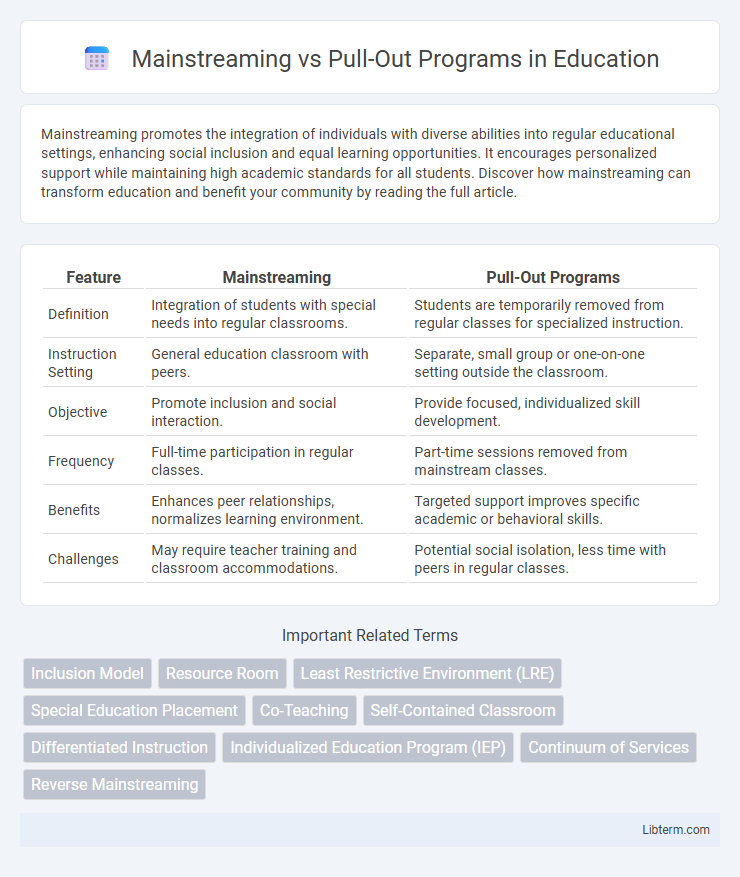Mainstreaming promotes the integration of individuals with diverse abilities into regular educational settings, enhancing social inclusion and equal learning opportunities. It encourages personalized support while maintaining high academic standards for all students. Discover how mainstreaming can transform education and benefit your community by reading the full article.
Table of Comparison
| Feature | Mainstreaming | Pull-Out Programs |
|---|---|---|
| Definition | Integration of students with special needs into regular classrooms. | Students are temporarily removed from regular classes for specialized instruction. |
| Instruction Setting | General education classroom with peers. | Separate, small group or one-on-one setting outside the classroom. |
| Objective | Promote inclusion and social interaction. | Provide focused, individualized skill development. |
| Frequency | Full-time participation in regular classes. | Part-time sessions removed from mainstream classes. |
| Benefits | Enhances peer relationships, normalizes learning environment. | Targeted support improves specific academic or behavioral skills. |
| Challenges | May require teacher training and classroom accommodations. | Potential social isolation, less time with peers in regular classes. |
Understanding Mainstreaming in Education
Mainstreaming in education integrates students with special needs into general education classrooms, promoting inclusion and equal access to curriculum alongside their peers. This approach supports social interaction and reduces stigma while providing specialized support as needed within the mainstream setting. Research shows mainstreaming enhances academic outcomes and social development by fostering an inclusive learning environment.
What are Pull-Out Programs?
Pull-out programs are specialized instructional sessions where students are temporarily removed from the general classroom to receive targeted support in areas such as speech therapy, special education, or language development. These programs provide personalized intervention tailored to individual learning needs, allowing educators to focus on specific skills without the usual classroom distractions. Pull-out services are designed to complement mainstream education by offering intensive assistance that enhances academic progress and addresses distinct challenges.
Key Differences Between Mainstreaming and Pull-Out
Mainstreaming integrates students with special needs into general education classrooms for most or all of the day, promoting inclusion and interaction with peers. Pull-out programs involve removing these students for specific periods to receive specialized instruction in a separate setting, targeting particular skill development. The key difference lies in the environment and instructional approach: mainstreaming emphasizes full participation in a typical classroom, while pull-out focuses on individualized support outside the regular class.
Benefits of Mainstreaming for Students
Mainstreaming offers students increased opportunities for social interaction and exposure to diverse learning environments, promoting inclusivity and peer modeling. It enhances academic achievement by allowing students with special needs to access the general curriculum alongside their non-disabled peers. Access to specialized support within mainstream classrooms helps students develop essential life skills and boosts their confidence and self-esteem.
Advantages of Pull-Out Programs
Pull-out programs offer personalized instruction by allowing educators to target specific learning needs and provide tailored interventions that may not be feasible in a mainstream classroom. These programs also create a quieter, less distracting environment, fostering better focus and skill development for students requiring additional support. Furthermore, pull-out sessions facilitate closer teacher-student interactions, promoting more effective assessment and progress monitoring.
Challenges of Mainstreaming Approaches
Mainstreaming approaches face significant challenges such as insufficient teacher training and inadequate resource allocation to meet the diverse needs of students with disabilities in general education classrooms. This often results in limited individualized support and increased classroom disruptions, hindering effective learning for both special and general education students. Furthermore, systemic barriers and lack of collaboration between special educators and general teachers exacerbate these difficulties, reducing the overall efficacy of mainstreaming programs.
Drawbacks of Pull-Out Initiatives
Pull-out programs often isolate students from their general education peers, potentially hindering social integration and causing feelings of exclusion. These initiatives can disrupt the continuity of classroom instruction, leading to gaps in learning and reduced access to grade-level curriculum. Furthermore, frequent removals from mainstream classes may result in stigmatization and lower self-esteem among special education students, negatively impacting their academic and emotional development.
Impact on Student Socialization and Inclusion
Mainstreaming programs enhance student socialization by integrating students with disabilities into general education classrooms, promoting peer interaction and inclusivity. Pull-out programs, while providing specialized instruction, may limit social opportunities by separating students from their peers during key social periods. Research indicates that mainstreaming fosters greater acceptance and inclusion, contributing to improved social skills and a sense of belonging among all students.
Academic Outcomes: Mainstreaming vs Pull-Out
Mainstreaming students in inclusive classrooms often leads to improved academic outcomes by providing continuous access to grade-level curriculum and peer interactions. Pull-out programs, while offering specialized instruction, may cause students to miss core classroom content, potentially hindering consistent academic progress. Research indicates mainstreaming supports higher achievement levels in reading and math by fostering engagement within the general education environment.
Choosing the Best Program for Diverse Learners
Mainstreaming integrates diverse learners into general education classrooms, promoting social interaction and access to the standard curriculum, while pull-out programs provide specialized instruction in separate settings to address specific learning needs. Selecting the best program depends on individual student profiles, including academic abilities, social skills, and support requirements, ensuring tailored educational experiences. Collaboration among educators, specialists, and families is essential to determine whether inclusion or targeted intervention maximizes student growth and engagement.
Mainstreaming Infographic

 libterm.com
libterm.com